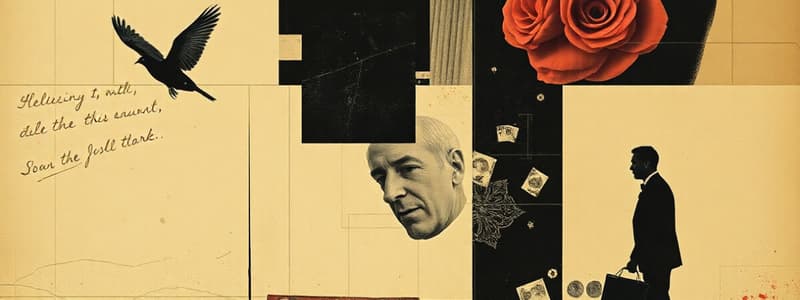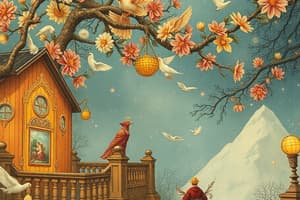Podcast
Questions and Answers
A ______ is a figure of speech that compares two things using 'like' or 'as'.
A ______ is a figure of speech that compares two things using 'like' or 'as'.
simile
A ______ describes something in non-literal terms, transforming its meaning.
A ______ describes something in non-literal terms, transforming its meaning.
metaphor
______ gives human-like qualities to nonhuman entities.
______ gives human-like qualities to nonhuman entities.
Personification
A statement such as 'I'm so hungry, I could eat a horse' is an example of ______.
A statement such as 'I'm so hungry, I could eat a horse' is an example of ______.
The use of ______ involves a contrast between reality and appearance.
The use of ______ involves a contrast between reality and appearance.
______ occurs when a writer makes an indirect reference to a person or event.
______ occurs when a writer makes an indirect reference to a person or event.
______ is the literary device that contrasts two different ideas or elements side by side.
______ is the literary device that contrasts two different ideas or elements side by side.
Using a phrase like 'he didn't make it' instead of 'he died' is an example of a ______.
Using a phrase like 'he didn't make it' instead of 'he died' is an example of a ______.
An ______ is a figure of speech that combines contradictory terms.
An ______ is a figure of speech that combines contradictory terms.
An ______ is a quotation or passage placed at the beginning of a text.
An ______ is a quotation or passage placed at the beginning of a text.
Flashcards are hidden until you start studying
Study Notes
Figures of Speech/Literary Devices
- Literary devices enhance writing by expressing ideas, emphasizing important concepts, and connecting readers to characters and themes.
- Each device serves a unique function that enriches storytelling and communication.
Simile
- Compares two different things using "as" or "like."
- Example: "She is vicious as a lion."
Metaphor
- Describes objects, ideas, or actions in non-literal terms, creating a direct comparison.
- Example: "The clouds are soft cottons in the sky."
Personification
- Attributes human-like qualities to nonhuman figures or abstract concepts, making them relatable.
Hyperbole
- Utilizes exaggerated statements for emphasis, not meant to be taken literally.
- Example: "I'm so hungry, I could eat a horse."
Irony
- Highlights contrasts between reality and appearance, often leading to unexpected outcomes.
- Example: A man enjoying his wife's cooking exclaims, "I shall never eat this!"
Allusion
- Makes indirect references to figures, places, events, or ideas from outside the text.
- Example: "Stop acting so smart—it's not like you're Einstein or something."
Juxtaposition
- Involves comparing and contrasting different ideas or characters to highlight differences.
- Example: "It was the best of times, it was the worst of times" from Dickens' A Tale of Two Cities.
Euphemism
- Replaces harsh or blunt terms with milder expressions to convey sensitivity.
- Example: "I'm so sorry, but he didn't make it" as a gentler way of saying someone has died.
Oxymoron
- Combines contradictory terms to create a striking effect or unique meaning.
- Examples: "Deafening silence," "organized chaos," "bittersweet."
Epigraph
- Introduces a text with a relevant quotation, poem, or passage to set the tone or theme.
- Example: "Lawyers, I suppose, were children once" as the epigraph for To Kill a Mockingbird.
Alliteration
- Features a series of words or phrases starting with the same sound, enhancing rhythm and memorability.
- Example: "Peter Piper picked a peck of pickled peppers."
Symbolism
- Uses an object, figure, or event to represent broader concepts, adding depth to the narrative.
- Example: In The Great Gatsby, the green light symbolizes Gatsby's hope and dreams.
Studying That Suits You
Use AI to generate personalized quizzes and flashcards to suit your learning preferences.




